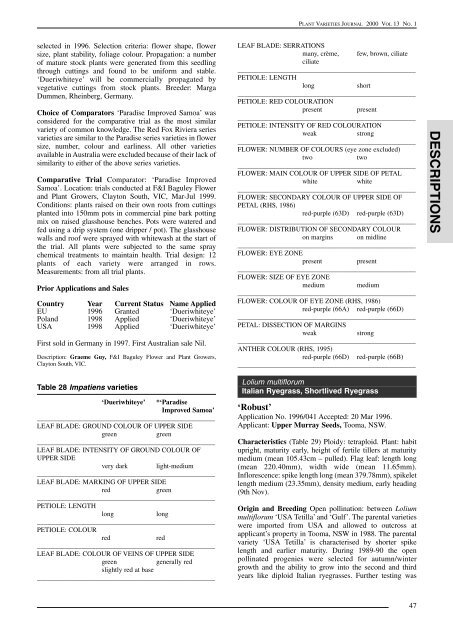53. Volume 13- Number 1 - IP Australia
53. Volume 13- Number 1 - IP Australia
53. Volume 13- Number 1 - IP Australia
You also want an ePaper? Increase the reach of your titles
YUMPU automatically turns print PDFs into web optimized ePapers that Google loves.
DESCR<strong>IP</strong>TIONS<br />
PLANT VARIETIES JOURNAL 2000 VOL <strong>13</strong> NO. 1<br />
selected in 1996. Selection criteria: flower shape, flower<br />
size, plant stability, foliage colour. Propagation: a number<br />
of mature stock plants were generated from this seedling<br />
through cuttings and found to be uniform and stable.<br />
‘Dueriwhiteye’ will be commercially propagated by<br />
vegetative cuttings from stock plants. Breeder: Marga<br />
Dummen, Rheinberg, Germany.<br />
Choice of Comparators ‘Paradise Improved Samoa’ was<br />
considered for the comparative trial as the most similar<br />
variety of common knowledge. The Red Fox Riviera series<br />
varieties are similar to the Paradise series varieties in flower<br />
size, number, colour and earliness. All other varieties<br />
available in <strong>Australia</strong> were excluded because of their lack of<br />
similarity to either of the above series varieties.<br />
Comparative Trial Comparator: ‘Paradise Improved<br />
Samoa’. Location: trials conducted at F&I Baguley Flower<br />
and Plant Growers, Clayton South, VIC, Mar-Jul 1999.<br />
Conditions: plants raised on their own roots from cuttings<br />
planted into 150mm pots in commercial pine bark potting<br />
mix on raised glasshouse benches. Pots were watered and<br />
fed using a drip system (one dripper / pot). The glasshouse<br />
walls and roof were sprayed with whitewash at the start of<br />
the trial. All plants were subjected to the same spray<br />
chemical treatments to maintain health. Trial design: 12<br />
plants of each variety were arranged in rows.<br />
Measurements: from all trial plants.<br />
Prior Applications and Sales<br />
Country Year Current Status Name Applied<br />
EU 1996 Granted ‘Dueriwhiteye’<br />
Poland 1998 Applied ‘Dueriwhiteye’<br />
USA 1998 Applied ‘Dueriwhiteye’<br />
First sold in Germany in 1997. First <strong>Australia</strong>n sale Nil.<br />
Description: Graeme Guy, F&I Baguley Flower and Plant Growers,<br />
Clayton South, VIC.<br />
Table 28 Impatiens varieties<br />
‘Dueriwhiteye’ *‘Paradise<br />
Improved Samoa’<br />
____________________________________________________<br />
LEAF BLADE: GROUND COLOUR OF UPPER SIDE<br />
green<br />
green<br />
____________________________________________________<br />
LEAF BLADE: INTENSITY OF GROUND COLOUR OF<br />
UPPER SIDE<br />
very dark light-medium<br />
____________________________________________________<br />
LEAF BLADE: MARKING OF UPPER SIDE<br />
red<br />
green<br />
____________________________________________________<br />
PETIOLE: LENGTH<br />
long<br />
long<br />
____________________________________________________<br />
PETIOLE: COLOUR<br />
red<br />
red<br />
____________________________________________________<br />
LEAF BLADE: COLOUR OF VEINS OF UPPER SIDE<br />
green<br />
generally red<br />
slightly red at base<br />
____________________________________________________<br />
LEAF BLADE: SERRATIONS<br />
many, crème, few, brown, ciliate<br />
ciliate<br />
____________________________________________________<br />
PETIOLE: LENGTH<br />
long<br />
short<br />
____________________________________________________<br />
PETIOLE: RED COLOURATION<br />
present<br />
present<br />
____________________________________________________<br />
PETIOLE: INTENSITY OF RED COLOURATION<br />
weak<br />
strong<br />
____________________________________________________<br />
FLOWER: NUMBER OF COLOURS (eye zone excluded)<br />
two<br />
two<br />
____________________________________________________<br />
FLOWER: MAIN COLOUR OF UPPER SIDE OF PETAL<br />
white<br />
white<br />
____________________________________________________<br />
FLOWER: SECONDARY COLOUR OF UPPER SIDE OF<br />
PETAL (RHS, 1986)<br />
red-purple (63D) red-purple (63D)<br />
____________________________________________________<br />
FLOWER: DISTRIBUTION OF SECONDARY COLOUR<br />
on margins on midline<br />
____________________________________________________<br />
FLOWER: EYE ZONE<br />
present<br />
present<br />
____________________________________________________<br />
FLOWER: SIZE OF EYE ZONE<br />
medium medium<br />
____________________________________________________<br />
FLOWER: COLOUR OF EYE ZONE (RHS, 1986)<br />
red-purple (66A) red-purple (66D)<br />
____________________________________________________<br />
PETAL: DISSECTION OF MARGINS<br />
weak<br />
strong<br />
____________________________________________________<br />
ANTHER COLOUR (RHS, 1995)<br />
red-purple (66D) red-purple (66B)<br />
____________________________________________________<br />
Lolium multiflorum<br />
Italian Ryegrass, Shortlived Ryegrass<br />
‘Robust’<br />
Application No. 1996/041 Accepted: 20 Mar 1996.<br />
Applicant: Upper Murray Seeds, Tooma, NSW.<br />
Characteristics (Table 29) Ploidy: tetraploid. Plant: habit<br />
upright, maturity early, height of fertile tillers at maturity<br />
medium (mean 105.43cm – pulled). Flag leaf: length long<br />
(mean 220.40mm), width wide (mean 11.65mm).<br />
Inflorescence: spike length long (mean 379.78mm), spikelet<br />
length medium (23.35mm), density medium, early heading<br />
(9th Nov).<br />
Origin and Breeding Open pollination: between Lolium<br />
multiflorum ‘USA Tetilla’ and ‘Gulf’. The parental varieties<br />
were imported from USA and allowed to outcross at<br />
applicant’s property in Tooma, NSW in 1988. The parental<br />
variety ‘USA Tetilla’ is characterised by shorter spike<br />
length and earlier maturity. During 1989-90 the open<br />
pollinated progenies were selected for autumn/winter<br />
growth and the ability to grow into the second and third<br />
years like diploid Italian ryegrasses. Further testing was<br />
47

















